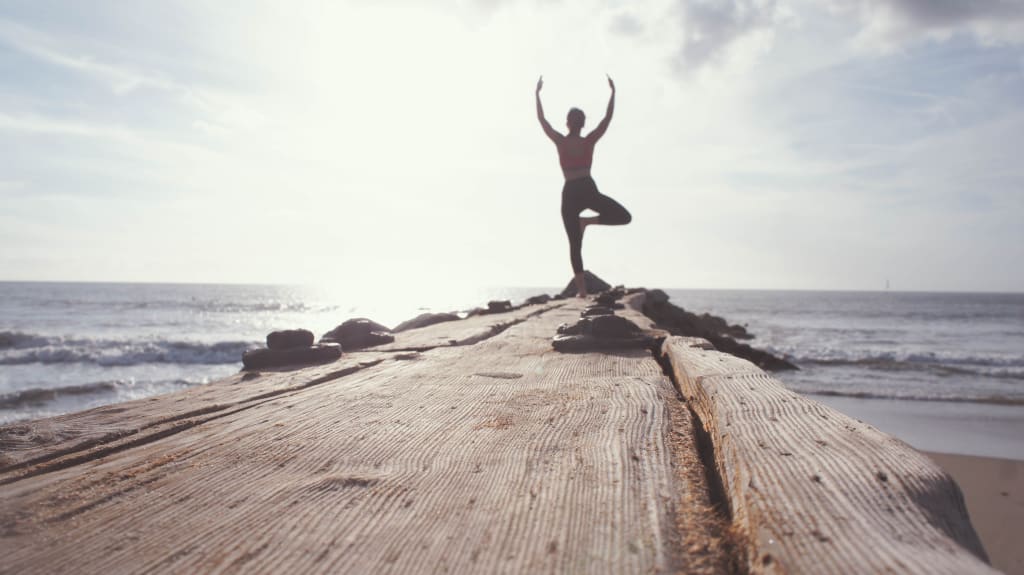Yoga Is Not for the Flexible...It Is for the Willing
The Top Five Myths This Yoga Teacher Hears That Stop People from Getting on Their Mats, and the Truths That Might Get You Closer

"You should do yoga."
I can almost guarantee that someone at some point has probably said this to you. They mean well, and are likely trying to offer you a solution to some problem you may have—pain, stress, or otherwise. But you resist for one reason or another and continue to avoid stepping onto your mat.
As a yoga teacher, I cannot tell you how many excuses I hear as to why people don't do yoga. I can also tell you that it is mostly due to fear that they won't be "good enough" to practice, but mostly, their objections come down to one of the following five myths.
Myth #1: You have to be flexible to practice.
"I can't do yoga, I'm not flexible enough."
I'm gonna let you in on a little secret...You don't need to be flexible to do yoga. There is not a membership card that you receive when you finally touch your toes for the first time.
While increased flexibility can be a benefit of regular practice, the degree to which you perceive "flexibility" actually has a lot more to do with the shape of your body than natural talent.
For instance, some people (myself included) will never be able to get both feet behind their heads. My legs in proportion to my torso are much too long to get both behind my head, and yet no one has shown up to revoke my membership card...
Remember that everyone's body is different and thus the way we each practice will be different, as well. Luckily, there are these handy little props—scubas blocks and straps—that we can use to make poses more accessible.
So please, before you object on the grounds of flexibility, please remember that yoga has very little to do with whether or not you can touch your toes and a lot to do with your willingness to reach for them in the first place.
Myth #2: You need to dedicate hours a day to yoga.
"I can't do yoga, I have no time."
This is one of my favourite objections because it allows me to show people that they often have more time than they think they do. We are in an era of what I like to call the "Busy Disease," in that we as humans equate busy with productive whether or not we actually end up getting work done.
Most yoga classes are an hour long, depending on the studio, and in the grand scheme of things, an hour is less than one percent of your week.
Less than one percent of your week.
Yes, you can dedicate less than one percent of your week to your well-being.
Now, if dedicating a whole hour once a week to shutting the world out and getting on your mat is inconceivable, picture this:
You wake up in the morning and instead of sitting on the toilet scrolling through Facebook, you leave your phone alone, go pee, and spend ten minutes moving your body through some poses. Alternatively, you can set an alarm fifteen minutes before you need to start getting ready for bed and do some yoga then.
Building a ten minute daily yoga routine that you can do at home is super simple, and you can even look up poses that will help specific issues you are facing.
Myth #3: My yoga teacher is gonna be all 'woo-woo.'
"I can't deal with the woo-woo."
Trust me, I have been in that class. You're settling into your first down dog, and suddenly the teacher says, "now, inhale the love and flower your anus upwards," and before you can say "BKS Iyengar," your whole practice is thrown because, if you're like me, you're wondering if you actually just heard your yoga teacher say "anus" all while trying to picture your anus as a flower and wondering how to follow this cue.
Now, believe me when I say this—I am pretty woo-woo, but I also pride myself on being low-key woo-woo. This means that, when I am teaching a public class, I prefer to keep the woo-woo aside and focus on the physical practice.
How do you find a teacher that doesn't put the woo-woo front and centre? Read those google reviews, try different studios, and know that when you find a teacher whose teaching style fits with your personality, you will have an infinitely better time practicing yoga.
Another side to the woo-woo objection is when I hear people say that they can't meditate.
Ah, yes. Meditation. The big M. That little bit at the end of class commonly known as "savasana" (really that just means corpse pose). This is actually a common objection that people give me for not coming to class.
Heres the thing. Meditation doesn't necessarily mean sitting super still, clearing your mind, and chanting. It can, but it doesn't have to. While there are many approaches to meditation, it is not a requirement of public classes.
Moreover, you don't have to meditate during savasana if you don't want to. I quite often have students who simply lie there and enjoy a few minutes of quiet before heading back into the chaos that is their lives. Personally, I do not meditate during savasana, I tend to just lie on my mat, allow my body to rest, and close my eyes for a bit.
What I do suggest is that you use that time to focus only on yourself and to be present in the moment. Too often are we concerned about our next steps that we forget to slow the eff down and breathe. Eventually, you may find that you do start to edge into "mediation" territory, but it is not a requirement, nor will anyone know if you're just lying there.
Myth #4: I'm not good enough/I can't do all the poses.
"I can't do yoga because I can't do any of the poses."
This one always makes me smile because there's not one person I have ever met who was good at anything their first time doing it, or even the second time. In the era of Insta-yoga and poses made up "for the gram," please let me assure you that not everyone in your yoga class will be balancing one-handed on top of a rock in the ocean surrounded by a beautiful sunset.
Even as a teacher, I take classes from those who inspire me, and I am constantly trying to expand my practice, both from a physical perspective and a mental one. I am always learning new things about anatomy and the energetics of poses, which then translate into me being able to tweak the way I am approaching a pose.
In my humble opinion, one of the best things about yoga is the endless learning opportunities and all the new things to discover about your practice.
The fact of the matter is that you have to start somewhere, and where better to start than where you are!?
Myth #5: All Yoga Is Hot Yoga
"I can't do yoga because I hate saunas."
Let me start by saying that hot yoga is a distinctly western phenomenon and is not the way the ancients practiced. In fact, very little of how we do yoga in the west is how it was originally practiced.
With that in mind, please remember that hot yoga is not for everyone, and despite its popularity, you do not have to do hot yoga. I encourage all of my students to keep a balance between hot and regular temperature yoga in their practices and here's why:
First of all, if you only practice in a hot room, you're at risk of developing a false sense of what your physical limits are. With temperatures typically above 95 degrees Fahrenheit, many find it easier to get into poses that require higher levels of flexibility. However, if you attempt this pose at a cooler temperature than you are used to without proper preparation, you can risk injury to your muscles or fascia.
Secondly, for those with elevated blood pressure or other medical conditions, hot yoga can do more harm than good. Since your internal temperature stays elevated even after class is finished, you should have a chat with your doctor to make sure none of your medications or conditions conflict with being exposed to elevated heat for an extended period of time.
So, if you tried hot yoga once and hated it, please do not write off yoga completely. Try a regular temperature class, and please be sure to try different types of yoga.
Practice Makes Practice...
The first time you step on your mat can be scary, and I encourage you to find a studio that you like, and remember that not every style of yoga will make you feel all warm and fuzzy inside.
Every teacher approaches their classes differently, and I cannot stress enough the importance of finding a teacher you like. For instance, I gave up long ago on being the serene teacher who takes herself too seriously and instead opt for a fun environment where my students can feel comfortable to laugh and explore their practices in a supportive environment.
So the next time someone says to you, "You should do yoga," remember that all those myths you have built up in your head are just that—myths. Just start where you are.
About the Creator
Sonia R.
Canadian; Spiritual Gangster; Yogini/RYT-200; Gluten Free Chef/ #bikinicladcook; World's Okay-est Rock Climber; Sommelier Wannabe; Travel Junkie and Storyteller.
Lover of Animals and Books.
Living life one cup of coffee at a time.
xoxo
S
Enjoyed the story? Support the Creator.
Subscribe for free to receive all their stories in your feed. You could also pledge your support or give them a one-off tip, letting them know you appreciate their work.






Comments
There are no comments for this story
Be the first to respond and start the conversation.